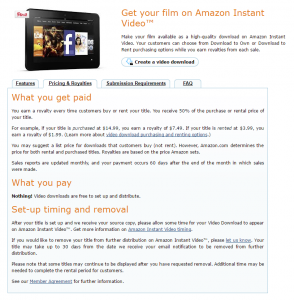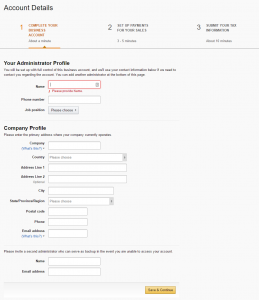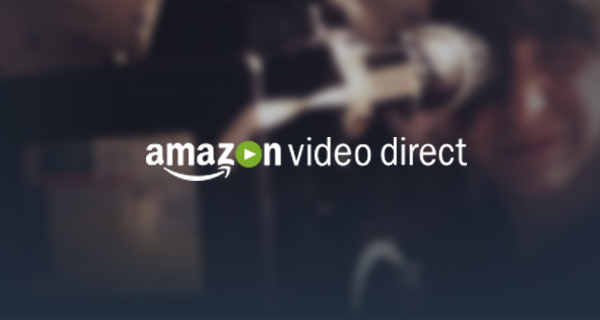Yesterday, in a surprise announcement, Amazon launched a new retail platform empowering video content creators to sell streaming media. It’s called Amazon Video Direct, and you can sign up now. What does it mean for filmmakers?
Previously, there were a few ways to get your films into the search results at Amazon.com, none of them ideal. The blue chip way was to somehow strike a high-level business deal, generally via traditional distribution channels, for both physical media and/or streaming media — big shot territory. For the rest of us 99%-ers, there was always (and still is) the option to just become an Amazon Marketplace seller, and use Amazon as an ordering system (you pack and ship DVDs/Blu-Rays after collecting the money, and giving a share of profit to Amazon), or to use Amazon as a complete order fulfillment system by sending them a batch of DVDs/Blu-Rays that they send out from their warehouses. If you happen to move product, they let you know when inventory is low enough for another batch…at your own risk, since your bulk might not eventually sell.

Lastly, for a long time there has been a parallel company under the Amazon umbrella called CreateSpace.com. Analogous to another Amazon acquisition we all know too well (and hate), Withoutabox.com, it had a clunky/primitive interface, and its technology was (and still is) way behind the times. The great thing about CreateSpace, though, is that it prints DVDs (not Blu-Rays, unfortunately) on-demand, as customers order them, so that you don’t have to risk buying in bulk. (Who among us doesn’t get free “merch” almost weekly from our creative circles of friends? It feels generous at first, until you realize — usually with a significant other looming nearby eager to get rid of clutter — that it’s just a melancholy off-loading of unsold discs from two-projects-ago.) Problem is, CreateSpace takes a gigantic, greedy cut of your profits from physical media: like, literally, if you set the retail price at ten bucks, you make about fifty cents in profit from a sale. It slides a teeny bit up from there, but seriously: can we justify charging much more than ten bucks for a DVD these days?
At some point years ago, CreateSpace began offering the option to take that uploaded DVD media and “transcode” the video (it’s magic!) for Amazon Instant Video streaming. So, when someone found your DVD on Amazon.com, they would also see an option to buy or rent the streaming version. Profit margins have been better for that, yet there was always a laughable limitation when streaming via CreateSpace: the maximum resolution is SD video quality (since it’s lifted from your retail DVDs). No joke: 720 by 480 pixels.
 So now, the newest kid on the block is Amazon Video Direct. CreateSpace hasn’t explained very well how existing libraries will be affected, and whether CreateSpace content will have the option to keep their “spots on the shelves” preserving sales history, while upgrading the source media to HD. In fact, existing CreateSpace users like myself are weirdly getting punished for having a loyal history with Amazon: anyone can sign up immediately for Amazon Video Direct as a new seller (see the sample registration page at left), but migration of existing CreateSpace streaming videos to the new platform is expected to take about four weeks. At this point, it’s also uncertain whether Amazon will offer any option to merge accounts.
So now, the newest kid on the block is Amazon Video Direct. CreateSpace hasn’t explained very well how existing libraries will be affected, and whether CreateSpace content will have the option to keep their “spots on the shelves” preserving sales history, while upgrading the source media to HD. In fact, existing CreateSpace users like myself are weirdly getting punished for having a loyal history with Amazon: anyone can sign up immediately for Amazon Video Direct as a new seller (see the sample registration page at left), but migration of existing CreateSpace streaming videos to the new platform is expected to take about four weeks. At this point, it’s also uncertain whether Amazon will offer any option to merge accounts.
 When it comes to video specifications for your uploads (seen at right), Amazon Video Direct is much more modernized than CreateSpace’s low-resolution, low-bitrate DVD rips from MPEG-2 SD video. In this sense and more, Amazon’s relatively low-key launch of its new platform is arguably a sleeping monster for people like us. You’ve probably heard about, and maybe tried out, services for retail video-on-demand (VOD) offered by VHX and Vimeo Pro. They are well-designed with extremely clean HD video capability, but there has always been an Achille’s heel at those platforms: they aren’t integrated into any retail search engine like Amazon’s. Proof positive: go to the bazillions of titles just sitting around, gathering no revenue and feeling super lonely (like my old film Lowertown Paducah, boo hoo). Like real estate, the problem is simple: location, location, location.
When it comes to video specifications for your uploads (seen at right), Amazon Video Direct is much more modernized than CreateSpace’s low-resolution, low-bitrate DVD rips from MPEG-2 SD video. In this sense and more, Amazon’s relatively low-key launch of its new platform is arguably a sleeping monster for people like us. You’ve probably heard about, and maybe tried out, services for retail video-on-demand (VOD) offered by VHX and Vimeo Pro. They are well-designed with extremely clean HD video capability, but there has always been an Achille’s heel at those platforms: they aren’t integrated into any retail search engine like Amazon’s. Proof positive: go to the bazillions of titles just sitting around, gathering no revenue and feeling super lonely (like my old film Lowertown Paducah, boo hoo). Like real estate, the problem is simple: location, location, location.
Granted, your profit margins are great at VHX and especially Vimeo On Demand, but then we’re right back to the real estate analogy: it costs more to live beachfront, right? Among all the graphics thrown onto this page, here is the one you really came to see:
Like being represented by an art gallery, or consignment agreements, the cut of your Amazon Instant Video revenue is 50%. That’s no change from the CreateSpace royalty schedule, but the streaming quality is better, and this is the newest thing with potentially more traffic. But there’s more: did you see that part about Amazon Prime? You can also offer to get paid by the hour; but the royalty rate is piss-poor/laughable: $0.15 (and probably lower from the indeterminate further option to allow pre-roll ads). That movie I mentioned of mine, Lowertown Paducah, is also over at IndieFlix, and while that placement can’t even come close to the viewer penetration potential at Amazon’s platforms, the payout there ranges from 3 to 5 cents per minute. And they do, after a bit of arm-wringing, pay.
So, is your content a good candidate for this new Amazon Video Direct service, and for Prime? Speaking for myself, I plan to flush out my old films this way. Many of us still control old projects that have some life left in them for niche audiences, and when it comes to this, the adage is: what’s to lose? But there’s a caveat: as explained in the help system at this link, eligible uploads must include English captions. Could be a big problem (and it is for me), while CreateSpace hasn’t clarified whether migrated films to the new service will be disabled or grandfathered if captions aren’t included.
As for deciding between sold/rented videos versus Prime revenue, I suppose that if you think you could get tons of views from something in your body of work (cat documentary?), you’ll benefit from the exposure implicit in Prime because members don’t have to pay to watch — and the nature of viral content is that more volumes of interaction increase exposure, search result hits, reviews, etc. Meanwhile, the biggest virtue of Amazon (that I think folks taking exception can easily overlook) is that all smart TV platforms, meaning your average set sold in the past few years, have Amazon Instant Video capability as a native part of the interface. That’s not true for Vimeo VOD, VHX, IndieFlix and so on. And Amazon’s got another stake in this: competing with Netflix. All of these ingredients make for fertile ground when you’re trying to get exposure for your movies, and maybe even paying the bills.

